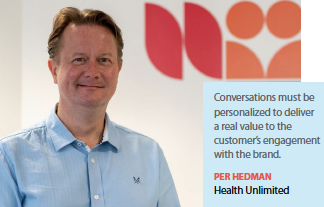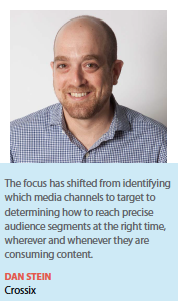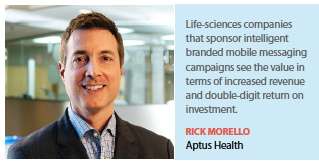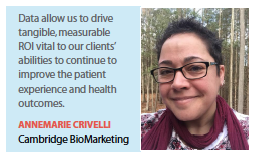Amazon does it. Zappos does it. Even your local grocery store does it. Yes, stores are using apps to personalize your shopping experience by directing coupons to you that are the most relevant to you and your shopping habits. All of this isn’t new, but what is new is that life-sciences companies are jumping on the personalization services bandwagon to provide a more precision experience for its consumers.
Last year, Pandora and Crossix made news when the companies announced their first partnership. The alliance gives pharma companies the ability to deliver ads to specific listener target audiences by Rx and/or health condition with guaranteed  HIPAA compliance. In the risk-adverse world of patient privacy, the partnership’s value to pharma was met with some skepticism from industry critics, but today the healthcare vertical at Pandora is thriving. As the industry realizes the benefits of personalized 1-to-1 messaging, Lee Ann Longinotti, executive head of industry healthcare at Pandora, predicts the vertical will continue to grow.
HIPAA compliance. In the risk-adverse world of patient privacy, the partnership’s value to pharma was met with some skepticism from industry critics, but today the healthcare vertical at Pandora is thriving. As the industry realizes the benefits of personalized 1-to-1 messaging, Lee Ann Longinotti, executive head of industry healthcare at Pandora, predicts the vertical will continue to grow.
Healthcare is now the third-largest revenue vertical at Pandora, trailing behind only the automotive and consumer packaged goods industries. Ms. Longinotti expects the healthcare market to continue to grow, as she has already witnessed a tremendous increase in awareness of Pandora’s healthcare solutions. She remembers it was not more than three years ago she would have to explain to CMOs in the healthcare field what Pandora was and show them how to download the app to their phone. “Today, Pandora’s targeting ability within the pharma industry is becoming better known, and the company is working with at least 30 pharmaceutical companies," she says.
The next step for Pandora will be to expand the vertical to include data that offer pharma brands the ability to target physicians, healthcare specialists, and surgeons as another primary target for the industry. Right now, Pandora can target general healthcare practitioners, but some brand managers are looking for more precision for their products.
“We know surgeons and doctors are listening to Pandora because they tweet us all  the time," Ms. Longinotti says. “We are looking at a potential data partnership that would enable us to target specific specialties such as cardiologists, oncologists, pediatricians, or orthopedics and more."
the time," Ms. Longinotti says. “We are looking at a potential data partnership that would enable us to target specific specialties such as cardiologists, oncologists, pediatricians, or orthopedics and more."
Given the strict regulations that govern the industry, it comes as no surprise that pharma has been somewhat hesitant to engage in consumer targeting trends, but that is changing, says Per Hedman, digital director, Health Unlimited.
While pharma companies are still cautious and careful to preserve patient privacy, data-driven approaches have added tremendous value in patient and treatment outcomes. “Today, there are some great examples of personalization in cancer, cardiovascular disease, specialized medicine, infectious diseases and other health conditions where meaningful messaging and conversations between patients and HCPs are happening," Mr. Hedman says.
Remaining HIPAA-compliant while reaching out to potential patients has been viewed as risky, but big data makes it less so, our experts say. “It’s important to note that in this age of online privacy vigilance, these mobile campaigns do not identify individuals through their phones, which ensures that privacy is protected," says Rick Morello, president of global life sciences at Aptus Health. “The consumer apps that carry ads allow for location sharing, but they don’t share any personally identifiable  information. With this approach, individuals can choose whether they want to provide their location up front when using specific applications and/or use their devices to manage their privacy preferences. This gives patients full control over whether they receive customized ads through this medium and method."
information. With this approach, individuals can choose whether they want to provide their location up front when using specific applications and/or use their devices to manage their privacy preferences. This gives patients full control over whether they receive customized ads through this medium and method."
The availability of big data and the power it holds to target messaging are definitely driving the move toward more personalized marketing.
“We are at a tremendous time in pharma marketing," says Annemarie Crivelli, director of digital at Cambridge BioMarketing. “Advancements in technology, especially data science, are shifting how we find, understand, and target patients and healthcare professionals."
Today, data science should be at the center of all digital efforts as a way to understand what motivates changes in customer behavior, Ms. Crivelli says. “It’s also important to make data simple to digest and to identify what is truly actionable."
According to Mr. Hedman, personalized messaging is being driven by the fact that brand managers no longer control the conversations about their products, and that control is now in the hands of consumers, therefore, conversations must be personalized to deliver a real value to the customer’s engagement with the brand.
“Amazon, Facebook, Netflix, and Google have shown us how using data can engage customers and add value to relationships," Mr. Hedman says. “We are living in a  new normal where banner ads are spam and continuous conversations with customers is now marketing."
new normal where banner ads are spam and continuous conversations with customers is now marketing."
At Crossix, the company that partners with Pandora, the focus is not just on the types of data available, but the ability to combine that data in new and innovative ways. “By connecting health data — such as clinical, Rx, claims, and EHR data — with consumer data, brands can uncover new insights about their core customers," says Dan Stein, senior VP, product strategy, Crossix. “In doing so, they can identify some of the key nonhealth factors that influence patient behavior and determine the best way to target those customers across all media channels."
The Impact of Data-Driven Marketing
Message delivery in Pandora’s personalized music environment increases its recall value, Ms. Longinotti says. Pandora commissioned research marketing company Neuro-Insight Research to assess the impact of its personalized music environment.
Neuro-Insight Research found that ads served within Pandora’s platform had greater resonance with the listener, leading to more memorable and engaging campaigns than what is typically found with other media formats.
The Stream of Consciousness Survey was conducted October through November 2016. One hundred Pandora listeners were split equally between the ages of 18 to 34 and 35 and older. Groups of four were outfitted with Steady-State Topography (SST) hardware to measure the brain’s response to a simulated Pandora experience. The results showed that messages on Pandora have a memorability that is 49% higher than overall AM/FM radio advertising; 36% more memorable than average TV advertising and 29% more memorable than in an overall mobile video advertising environment.
“So we know now, based on science, that this personalized platform is definitely producing better results, at the same time that it is also collecting a billion different data signals every single day from listeners," Ms. Longinotti says. “Because music resonates emotionally with people, the environment automatically gives marketers an edge because it is already super personal."
Mr. Hedman says customer insight data can inform digital strategy, creative, programming, and content that motivates desire, ongoing action, and longer-term engagement. “Data allow us to drive tangible, measurable ROI vital to our clients’ ability to continue to improve the patient experience and health outcomes," he says.
To leverage the power that personalized, timely, intelligent messaging has in clearing some of the barriers to prescription adherence and persistence, Aptus Health recently acquired a company called EngagedMedia. Its mobile-first messaging platform enables life-sciences companies to communicate and engage with patients based on real-time pharmacy claim data.
By deploying timely, targeted messaging related to medication refills, pharmacy benefits status, and other aspects of support, the platform provides a scaled mobile solution for life-sciences companies to address the needs of individual patients who have been prescribed a specific medication.
According to Mr. Morello, this approach has driven positive results for both manufacturers and patients.
“For example, if a patient goes to pick up a prescription at the pharmacy only to learn that their prescription coverage has been denied due to additional requirements from the health insurer, that’s understandably frustrating for the patient," he says. “We’re able to proactively deliver a notification to that patient before he or she picks up the prescription along with an option to submit an appeal for coverage to the insurer on the patient’s behalf — all through a patient’s mobile device."
Data-driven messages such as these help people stay on their therapy as prescribed, while delivering convenience and a positive experience with the brand. People value this kind of personalized service, Mr. Morello says. In fact, more than 1.5 million patients have enrolled in these programs.
“Life-sciences companies that sponsor these intelligent branded mobile messaging campaigns see the value in terms of increased revenue and double-digit returns on investment," he adds. “Most importantly, these data-driven programs show measurable impact. On average, patients enrolled in our programs refill their prescriptions at a rate that is 35% higher compared with non-engaged patient participants, and stay on their therapy 27% longer. In addition, we are able to measure the impact of individual messages to certain patient segments; based on our experience and performance data, we can revise and adapt programs to continuously improve results for our clients."
Undeniably, data are central to driving actions that create meaningful change in health and there is plenty of data out there. “Physicians provide feedback during face-to-face interactions, through interactive detail aids, and on social media," Mr. Hedman from Health Unlimited adds. “Patient data are more readily available through anonymized and double opt-in patient adherence and treatment support programs and from growing advocacy groups and patient communities where patients interact with others in the treatment journey."
Using Data to Enhance Customer Insights
Personalized communication is the long-term promise of big data — the ability to better profile, reach, and engage health audiences to provide support throughout the patient journey, Mr. Stein says. Understanding how different segments of a population engage with content is key to an efficient use of marketing resources, and a more effective use of the audience’s time. This includes knowing which digital channels they prefer, what messages they like, the optimal time to deliver that content, and more.
Effective personalization is not only about the content of the messaging, it’s also about the timing, Mr. Stein adds. As anyone who has worked in patient segmentation knows, the patient journey is hardly ever linear. By using analytics to examine health data across millions of patients, specific pathways can be identified to drive desired degrees of personalization. This allows brands the ability to intercept patients at the moments when they need the most support.
These enhanced customer insights allow brands to unify their marketing approach across multiple channels. “The focus shifts from identifying which media channels to target, to determining how to reach precise audience segments at the right moment wherever and whenever they are consuming content," Mr. Stein says.
Mr. Morello also stresses the value of using individualized statistical models that predict how a particular physician will respond to educational and promotional stimuli when delivered as part of an integrated program. In addition to behavioral history, inputs to profiles may include an HCP’s practice demographic, the prescription size, market share, and treatment pathway they’re associated with, client segmentation, and other attributes such as managed care access.
“The outputs of this model can inform the right mix of communication tools, from the light engagement of a clinical alert or hyper-targeted mobile message to the deeper engagement of an interactive, expert-led piece of content, Mr. Morello says. “For pharma marketers, this means greater insights into the right mix of channels that will increase the likelihood that their messaging will be seen, assimilated, and acted upon by their target physician audience to bring about positive results, with far less waste."
Another approach facilitated by the massive amount of data available is predictive analytics, Mr. Stein from Crossix says. This approach allows brand managers to base their marketing strategy not on what their customers have done in the past, but on what they are most likely to do in the future. “This is key to enhancing customer insights and targeting for pharma marketers," he says.
Combining prescriber data with consumer and demographic data around HCPs can be tremendously successful when assessing HCP marketing.
“Seeing the HCP holistically allows brands to target the audience wherever they are — on both endemic professional websites and via programmatic targeting across digital platforms," Mr. Stein says.
Another form of personalization is geo-targeting. Consumers are becoming increasingly comfortable with location-based marketing. Take Starbucks as an example: its app allows consumers to place orders to the store that is closest to them at the time of the order. Starbucks reports that using targeted ads based on a consumer’s proximity increases the likelihood customers will enter a store by a factor of 100%.
“Location-based geo-targeting is playing an increasingly important role in the world of digital advertising," Mr. Morello says. “In an era of mobile devices, where nearly every consumer walks around with a location-aware smartphone in his or her pocket, more marketers plan to increase their spend on geo-targeted campaigns. With precise location data, combined with other proprietary and third-party healthcare and behavioral data, we’re able to engage consumers and their healthcare professionals at the point-of-care. We have plenty of evidence to show that data-driven ads effectively drive behavior and contribute to new prescription lift for clients’ brands and deliver measurable return on investment."
Combining data with other tools in the tech stack, such as a best-in-class CRM, provides customized and personalized experiences for segmentation, dynamic, and predictive content, Ms. Crivelli adds. “Advanced analytics tools help us to track the user experience across each touchpoint and allows us to understand what is working to achieve a higher conversion rate and modify what isn’t. Data provide unique opportunities to craft a custom and personalized message to each patient along every step of the diagnosis journey."
Data can be used to both define key customer segments and provide a roadmap for deeper engagement. By combining health, consumer, and media data, brands can gain a holistic view of their audiences and identify the best ways to engage them. “In the past, some of the most compelling customer insights were gleaned from focus groups or patient surveys," Mr. Stein says. While this provided valuable qualitative data, self-reported metrics can only give a partial view into patient behavior. By analyzing data points across millions of patients, new patterns emerge that can help brands better understand and more effectively segment their core audiences. For example, is there a surprising correlation between adherence rates and households with children under 18? Are there socioeconomic trigger points that impact health outcomes?
“Understanding the health and non-health factors that prompt behavior change can help brands determine how to best communicate with their customers," Mr. Stein says.
Unfortunately, he says there continues to be a disconnect in the industry between how well brands understand their customers and how effectively they activate those audiences across media channels.
Bridging that gap entails using audience-based analytics to improve targeting.
Campaign measurement and optimization tools tie media exposure to patient behavior and sales, so brands can fully understand the ROI for their marketing campaigns.(PV)
~~~~~~~~~~~~~~~~~~~~~~~~~
Pandora Case Study
Pandora, the largest source of personalized music streaming in the U.S. uses its own proprietary data trove in partnership with other data analytics companies to help pharma reach healthcare consumers in a highly targeted way. Through deep data capabilities, Pandora can target messaging down to the specific listener by device, age, gender, ethnicity, geography, behavior or any of the 2,000+ audience segments they have available. In a test pilot with a leading pharmaceutical brand, Pandora targeted 25 to 49 year-old women in a specific geographical area using mobile audio and display ads.
The results of that campaign test were:
213% Lift in Brand Awareness
183% Lift in Message Association
30% Increase in Purchase Intent


















